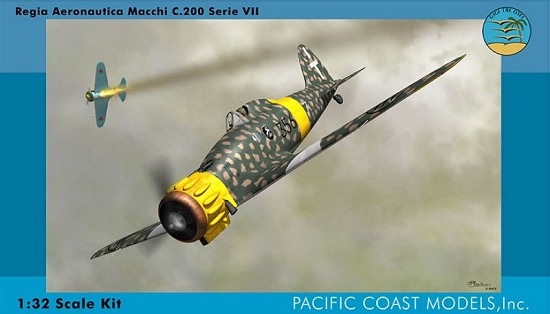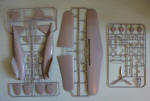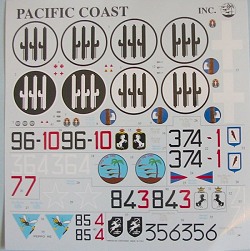
| KIT: | Pacific Coast Hobbies 1/32 C.200 serie VII |
| KIT #: | 32001 |
| PRICE: | $46.98 from www.pacmodels.com |
| DECALS: | 6 options |
| REVIEWER: | Tom Cleaver |
| NOTES: | Short run |

| HISTORY |
During the Second World War, Italian aircraft were subjected to distorted propaganda that played on the fact the Italians were using aircraft that did not look as aerodynamically advanced as did the aircraft being used by the Allies. The Italian air industry was hobbled by older production techniques, and by the need to meet design specifications issued by an overly‑ conservative Regia Aeronautica, and to cater to the extreme conservatism of Italian combat pilots when it came to such questions as the supremacy of the monoplane over the biplane, the need for enclosed cockpits, the need for a heavy armament, and other things considered de rigeur in the aeronautical state of the art. It didn't help that the Italian aircraft industry had nothing like the Merlin or Daimler‑Benz series of in‑line engines, or the high‑powered radials created by Pratt & Whitney.
That said, just about everything anyone "knows" about Italian aircraft from reading non‑Italian sources is false, due to the "hang‑over" created by Second World War propaganda.
A prime example of this is the Macchi‑Castoldi series of fighters, and particularly the progenitor of the series, the C.200 Saetta (which can be translated as both “Lightning Bolt” or “Arrow” ‑ the weapons of Jupiter).
The Castoldi fighters had a similar background and pedigree to that of Reginald J. Mitchell's Spitfire, since Mario Castoldi was his sharpest competitor in the creation of high speed seaplanes for the Schneider Cup Trophy competition that lasted from 1920 to 1931. Castoldi's racers had been top competitors, with the M.39 winning the 1926 Schneider competition, and the M.C.72 going on in 1933 to beat the record of the Supermarine S.6B by setting a world air speed record of 423.82 m.p.h. Unfortunately, the problems in engine development that had kept the M.C.72 from beating the S.6B to win the Schneider Cup outright would also dog the development of Castoldi's fighters.
The Schneider influence on the C.200 was not so apparent upon its rollout, since the best engine the Italians had available was the Fiat A.74 R.C.38, a magnificent powerplant derived from Gnome‑Rhone designs, but capable of only 870 h.p. Another stumbling block was the insistence by the Air Force that the best possible field of view for the pilot was paramount before aerodynamic cleanliness. The result was an airplane with a bulky, drag‑producing radial in a poorly‑designed cowling, matched to a humped‑back fuselage that completely eradicated all evidence of the fighter's racer lineage.
Flight trials following first flight on December 24, 1937, revealed the C.200 was singularly maneuverable, with exceptionally well‑harmonized controls and no vices. One remarkable bit of aerodynamic sleight-of-hand was the asymmetric wing, in which the left wing was longer than the right, which effectively canceled engine torque and added to the airplane's maneuverability. Like all other Italian fighters, it was lightly armed in comparison with its contemporaries, carrying only two .50 caliber machine guns with 370 rounds per gun.
The conservative pilots of the Italian fighter arm disliked the sliding canopy. The C.R.42‑equipped 4 Stormo refused to take the first C.200s because the monoplane ‑ as maneuverable as it was ‑ was less so than their biplanes. The pilots of 1 Stormo, who had flown the C.R.32 in the Spanish Civil War, were most anxious to convert to the C.200 since their experiences over Spain had convinced them the day of the biplane was over.
The C.200 did not see combat until June 1940, when the aircraft of the 6 Gruppo Autonomo in Sicily provided escort to S.79 Sparvieros bombing Malta. When faced by the Hawker Hurricane, it was shown that while they were both of similar performance, the C.200 had a considerably better climb rate and could out‑turn and out‑dive the British fighter, as well as having an equal ability to absorb punishment. In March 1941,Saettas of the 150 Gruppo entered combat over Greece while the C.200s of the 374 Squadriglia arrived in Libya, followed shortly by the similarly‑ equipped 153 Gruppo. That summer, the Corpo di Spedizio Italiano was formed for operations in the Soviet Union, with a fighter element equipped with 59 Saettas of the 22 Gruppo.
While Allied propaganda made fun of the way the C.200 looked, Allied fighter pilots found it a worthy opponent in the hands of a skilled pilot, and accorded it respect. A standard C.200 weighing 5,121 pounds attained a maximum speed of 312 mph at 14,759 ft., while an altitude of 3,280 ft. was attained in 1 minute, 3 seconds, a very creditable climb performance. Service ceiling was 29,200 feet, and normal range was 354 miles.
C.200s were among the Italian fighters that joined the Co‑ Belligerent Air Force after the Italian surrender in September 1943, and the airplane served to the end of the war.
| THE KIT |
 I
am not aware of any other 1/32 scale C.200 models, though some odd vacuform
may have slipped under the radar back when I did not build in this scale.
(Your editor has been reminded by readers that Craftworks does/did this
aircraft as a resin kit in this scale) This kit by Pacific Coast Models is the first injection-molded kit of the
Saetta in this scale, and it is excellent. The mod
I
am not aware of any other 1/32 scale C.200 models, though some odd vacuform
may have slipped under the radar back when I did not build in this scale.
(Your editor has been reminded by readers that Craftworks does/did this
aircraft as a resin kit in this scale) This kit by Pacific Coast Models is the first injection-molded kit of the
Saetta in this scale, and it is excellent. The mod el was reviewed by
Maurizio Di Terlizzi - who some call “Mr. Macchi” - for dimensions and
accuracy, and passed his inspection with flying colors. It depicts the
Serie VII version, which was the main production model.
el was reviewed by
Maurizio Di Terlizzi - who some call “Mr. Macchi” - for dimensions and
accuracy, and passed his inspection with flying colors. It depicts the
Serie VII version, which was the main production model.
The injection-molded plastic parts and the resin detail parts are made by
MPM, and they are fully up to that company’s recent standards with petite
engraved detail and very
 realistic fabric detail on the control surfaces.
The resin parts are crisply molded and include a really stunning one-piece
cowling, a real example of the mold-maker’s art with all the bumps and
curves on the original. There are two vacuformed canopies.
realistic fabric detail on the control surfaces.
The resin parts are crisply molded and include a really stunning one-piece
cowling, a real example of the mold-maker’s art with all the bumps and
curves on the original. There are two vacuformed canopies.
Decals are by Skymodels, and provide markings for no less than six different airplanes, with very nice full-color profiles. These are to the usual standard one has come to expect from this company.
The photo-etch set (not shown) is done by Eduard.
| CONCLUSIONS |
This kit looks like a scale-up of the really nice Pacific Coast Models 1/48 C.200 Saetta, which in my book was the best C.200 kit available - until this one came along. It certainly appears to be as buildable as its smaller cousin, with the promise of sharp trailing edges on the wings and tail surfaces, and good detail in the cockpit and wheel wells. It will certainly stand positive comparison with the 1/32 Hasegawa Bf-109s and Fw-190s when completed, and it is competitively priced with these kits.
I’ve always liked the C.200, probably because it is so “clunky-looking.” This one goes to the top of the to-do pile, and I will definitely be looking forward to the C.202 Folgore promised for mid-summer and the C.205 Veltro promised for September (availability dates are estimated). Pacific Coast Models has this C.200 available now bagged for those who can’t wait a few weeks to get it in the box.
Highly recommended for those who love Italian airplanes and large-scale models.
June 2005
Thanks to Pacific Coast Models for the review copy. Order yours at www.pacmodels.com
If you would like your product reviewed fairly and quickly by a site that has around 300,000 visitors a month, please contact me or see other details in the Note to Contributors.